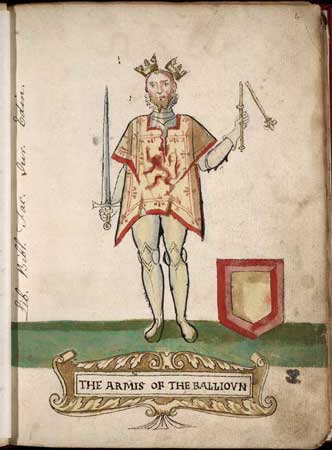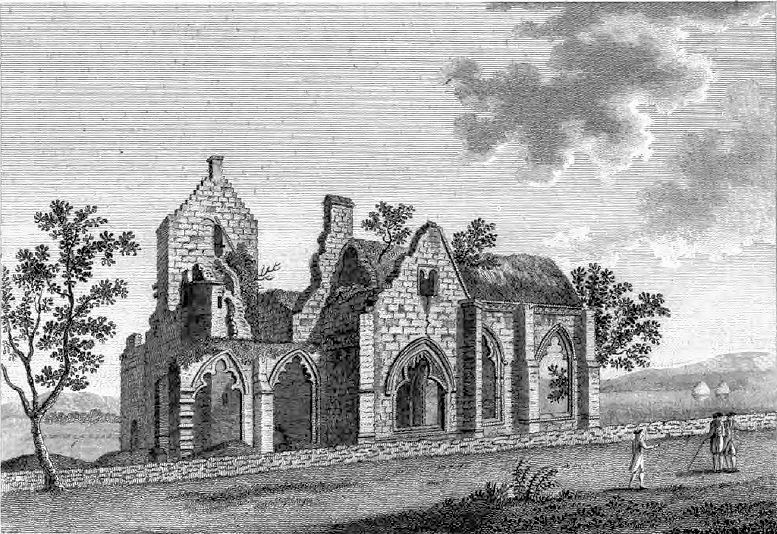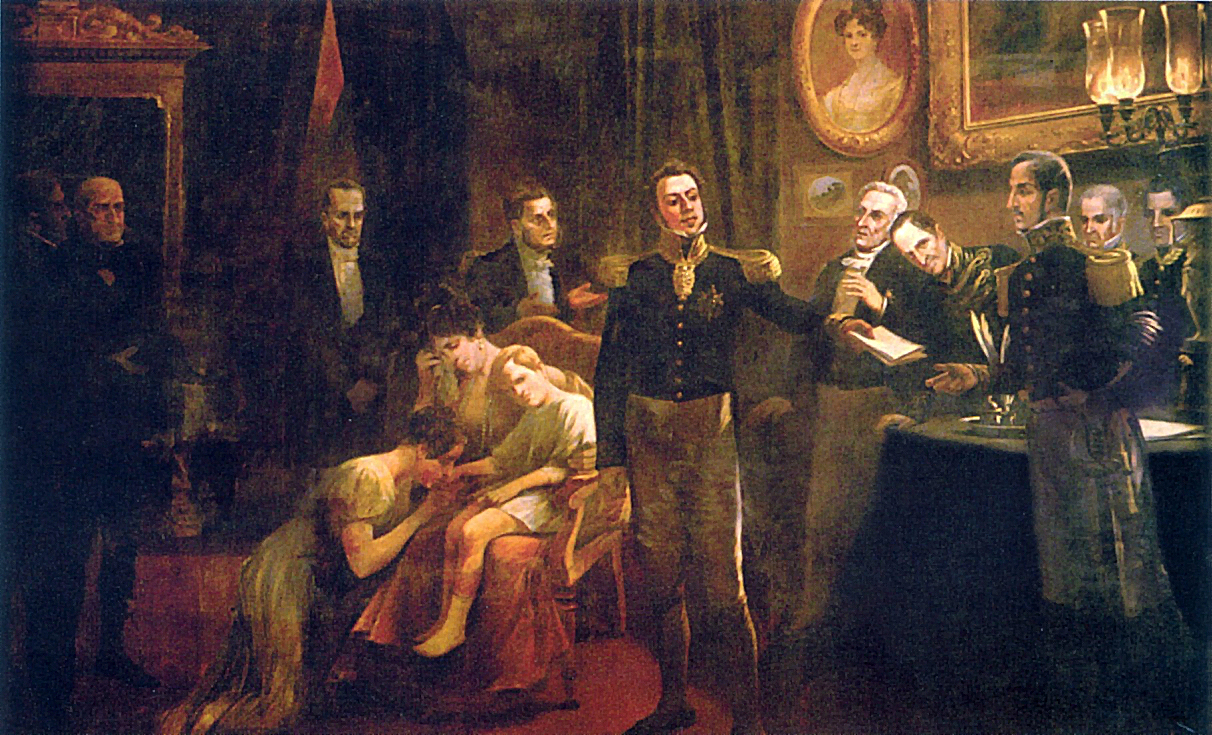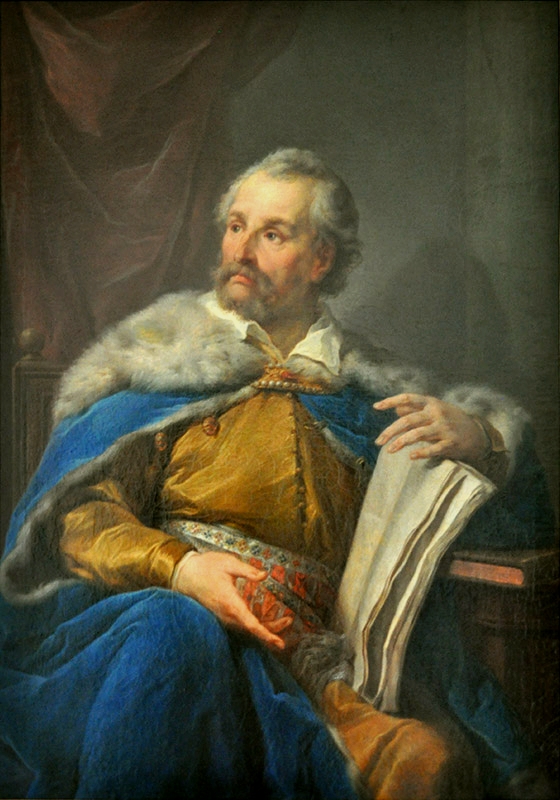|
John Comyn
John Comyn III of Badenoch, nicknamed the Red ( 1274 – 10 February 1306), was a leading Scottish baron and magnate who played an important role in the First War of Scottish Independence. He served as Guardian of Scotland after the forced abdication of his uncle, King John Balliol (1292–1296), in 1296, and for a time commanded the defence of Scotland against English attacks. Comyn was stabbed to death by Robert the Bruce before the altar at the church of the Greyfriars at Dumfries. His father, John Comyn II, known as the Black Comyn, had been one of the competitors for the Crown of Scotland, claiming his descent from King Donald III. His mother was Eleanor Balliol, sister of King John Balliol. He had, moreover, links with the royal house of England: in the early 1290s, he married Joan de Valence, cousin of King Edward I. Comyn family On the eve of the Wars of Independence, the Comyns were one of the dominant families of Scotland, with extensive landholdings in ... [...More Info...] [...Related Items...] OR: [Wikipedia] [Google] [Baidu] |
Lord Of Badenoch
{{Use dmy dates, date=April 2022 The Lord of Badenoch was a magnate who ruled the lordship of Badenoch in the 13th century and early 14th century. The lordship may have been created out of the territory of the Meic Uilleim, after William Comyn, jure uxoris Earl of Buchan, Justiciar of Scotia and Warden of Moray defeated Gille Escoib MacUilleim. However, there is no evidence that the Meic Uilleim held lands in this area. After the death of John III in 1306, the lordship was taken into royal hands, although it was still claimed by his son John. The Lordship was included in the vast Earl of Moray, Earldom of Moray when it was resurrected for Thomas Randolph, 1st Earl of Moray, Thomas Randolph. The following figures were Lords of Badenoch: *Walter Comyn, Lord of Badenoch, jure uxoris Earl of Menteith (d.s.p. 1258) *John Comyn I of Badenoch, John Comyn I (d. 1277) *John Comyn II of Badenoch, John Comyn II (d. 1302) *John Comyn III of Badenoch, John Comyn III (d. 1306) * Forfeit; i ... [...More Info...] [...Related Items...] OR: [Wikipedia] [Google] [Baidu] |
Edward I Of England
Edward I (17/18 June 1239 – 7 July 1307), also known as Edward Longshanks and the Hammer of the Scots (Latin: Malleus Scotorum), was King of England from 1272 to 1307. Concurrently, he was Lord of Ireland, and from 1254 to 1306 ruled Duchy of Gascony, Gascony as Duke of Aquitaine in his capacity as a vassal of the French king. Before his accession to the throne, he was commonly referred to as the Lord Edward. The eldest son of Henry III of England, Henry III, Edward was involved from an early age in the political intrigues of his father's reign. In 1259, he briefly sided with a baronial reform movement, supporting the Provisions of Oxford. After reconciling with his father, he remained loyal throughout the subsequent armed conflict, known as the Second Barons' War. After the Battle of Lewes, Edward was held hostage by the rebellious barons, but escaped after a few months and defeated the baronial leader Simon de Montfort at the Battle of Evesham in 1 ... [...More Info...] [...Related Items...] OR: [Wikipedia] [Google] [Baidu] |
Wars Of Scottish Independence
The Wars of Scottish Independence were a series of military campaigns fought between the Kingdom of Scotland and the Kingdom of England in the late 13th and 14th centuries. The First War (1296–1328) began with the English invasion of Scotland in 1296 and ended with the signing of the Treaty of Edinburgh–Northampton in 1328. The Second War (1332–1357) began with the English-supported invasion by Edward Balliol and the "Disinherited" in 1332 and ended in 1357 with the signing of the Treaty of Berwick. The wars were part of a great crisis for Scotland, and the period became one of the most defining times in its history. At the end of both wars, Scotland retained its status as an independent state. The wars were important for other reasons, such as the emergence of the longbow as a key weapon in medieval warfare. The First War of Independence: 1296–1328 Background King Alexander III of Scotland died in 1286, leaving his three-year-old granddaughter Margaret, Maid ... [...More Info...] [...Related Items...] OR: [Wikipedia] [Google] [Baidu] |
House Of Plantagenet
The House of Plantagenet (Help:IPA/English, /plænˈtædʒənət/ Help:Pronunciation respelling key, ''plan-TAJ-ə-nət'') was a royal house which originated from the Medieval France, French county of Anjou. The name Plantagenet is used by modern historians to identify four distinct royal houses: the Angevin kings of England, Angevins, who were also counts of Anjou; the main line of the Plantagenets following the loss of Anjou; and the Houses of House of Lancaster, Lancaster and House of York, York, two of the Plantagenets’ Cadet branch, cadet branches. The family held the English throne from 1154, with the accession of Henry II of England, Henry II, until 1485, when Richard III of England, Richard III died in battle. England was transformed under the Plantagenets, although only partly intentionally. The Plantagenet kings were often forced to negotiate compromises such as Magna Carta, which constrained royal power in return for financial and military support. The king was no ... [...More Info...] [...Related Items...] OR: [Wikipedia] [Google] [Baidu] |
Donald III Of Scotland
Donald III ( Medieval Gaelic: ''Domnall mac Donnchada''; Modern Gaelic: ''Dòmhnall mac Dhonnchaidh''; –1099) was King of Alba (Scotland) from 1093–1094 and 1094–1097. He was known as ''Domnall Bán'' or "Donald the Fair", anglicized as Donalbain. Early life Donald was born about 1033, during the reign of his great-grandfather King Malcolm II. He was the second known son of the king's grandson, Duncan. Malcolm died when Donald was a baby, at age 80, and Donald's father became king. King Duncan I however, perished in 1040 when Donald was still a boy, killed by Mormaer Macbeth, yet another grandson of King Malcolm II, who usurped his place as king. Following his father's death, Donald went into hiding in Ireland for 17 years, for fear that he would be killed by Macbeth. His elder brother, Malcolm, went to England. It was during this time that Malcolm's grandfather, Crínán of Dunkeld, who was married to Malcolm II's daughter, was killed fighting Macbeth. When Malc ... [...More Info...] [...Related Items...] OR: [Wikipedia] [Google] [Baidu] |
Dumfries
Dumfries ( ; ; from ) is a market town and former royal burgh in Dumfries and Galloway, Scotland, near the mouth of the River Nith on the Solway Firth, from the Anglo-Scottish border. Dumfries is the county town of the Counties of Scotland, historic county of Dumfriesshire. Before becoming King of Scots, Robert the Bruce killed his rival John Comyn III of Badenoch at Greyfriars Kirk in the town in 1306. The Young Pretender had his headquarters here towards the end of 1745. In World War II, the Norwegian armed forces in exile in Britain largely consisted of a brigade in Dumfries. Dumfries is nicknamed ''Queen of the South''. This is also the name of the town's Queen of the South F.C., football club. People from Dumfries are known colloquially in Scots language as ''Doonhamers''. Toponymy There are a number of theories on the etymology of the name, with an ultimately Common Celtic, Celtic derivation (either from Common Brittonic, Brythonic, Old Irish, Gaelic or a mixture of b ... [...More Info...] [...Related Items...] OR: [Wikipedia] [Google] [Baidu] |
Greyfriars Church, Dumfries
Greyfriars Church, Dumfries, is a Category A listed building in Dumfries, in southwest Scotland. The current Greyfriars Church building was built from 1866 to 1868 in the Victorian Gothic style, designed by architect John Starforth. It is situated in a prominent position at the top of the High Street, and is constructed of local red sandstone taken from Locharbriggs Quarry. The building has an abundance of ornate decorative stonework, including impressive figures and foliage around the entrance doorway. These carvings are attributed to local stonemason and sculptor, William Flint. Greyfriars Church was where Robert the Bruce murdered John Comyn John Comyn III of Badenoch, nicknamed the Red ( 1274 – 10 February 1306), was a leading Scottish baron and magnate who played an important role in the First War of Scottish Independence. He served as Guardian of Scotland after the forced ... in 1306. History (buildings) The location of building is on or near some of the ear ... [...More Info...] [...Related Items...] OR: [Wikipedia] [Google] [Baidu] |
Abdication
Abdication is the act of formally relinquishing monarchical authority. Abdications have played various roles in the Order of succession, succession procedures of monarchies. While some cultures have viewed abdication as an extreme abandonment of duty, in other societies (such as pre-Meiji Restoration Japan), abdication was a regular event and helped maintain stability during political succession. Historically, abdications have occurred both by force (where the regnant was ''Dethronement, dethroned'', thus forced to abdicate on pain of death or other severe consequences) and voluntarily. Some rulers are deemed to have abdicated wiktionary:in absentia, ''in absentia'', vacating the physical throne and thus their position of power, although these judgements were generally pronounced by successors with vested interests in seeing the throne abdicated, and often without or despite the direct input of the abdicating monarch. Recently, due to the largely ceremonial nature of the regnan ... [...More Info...] [...Related Items...] OR: [Wikipedia] [Google] [Baidu] |
Magnate
The term magnate, from the late Latin ''magnas'', a great man, itself from Latin ''magnus'', "great", means a man from the higher nobility, a man who belongs to the high office-holders or a man in a high social position, by birth, wealth or other qualities in Western Christian countries since the medieval period. It also includes the members of the higher clergy, such as bishops, archbishops and cardinals. In reference to the medieval, the term is often used to distinguish higher territorial landowners and warlords, such as counts, earls, dukes, and territorial-princes from the baronage. In Poland the ''szlachta'' (nobles) constituted one of the largest proportions of the population (around 10-12%) and 'magnat' refers to the richest nobles, or nobles of the nobility - even though they had equal voting rights in Poland's electoral monarchy. England In England, the magnate class went through a change in the later Middle Ages. It had previously consisted of all tenants-in-chie ... [...More Info...] [...Related Items...] OR: [Wikipedia] [Google] [Baidu] |
Baron
Baron is a rank of nobility or title of honour, often Hereditary title, hereditary, in various European countries, either current or historical. The female equivalent is baroness. Typically, the title denotes an aristocrat who ranks higher than a lord or knight, but lower than a viscount or count. Often, barons hold their fief – their lands and income – directly from the monarch. Barons are less often the vassals of other nobles. In many kingdoms, they were entitled to wear a smaller form of a crown called a ''coronet''. The term originates from the Late Latin, Latin term , via Old French. The use of the title ''baron'' came to England via the Norman Conquest of 1066, then the Normans brought the title to Scotland and Southern Italy. It later spread to Scandinavian and Slavic lands. Etymology The word '':wikt:baron, baron'' comes from the Old French , from a Late Latin "man; servant, soldier, mercenary" (so used in Salic law; Alemannic law has in the same sense). The sc ... [...More Info...] [...Related Items...] OR: [Wikipedia] [Google] [Baidu] |
English Expedition To Flanders (1297–98)
English usually refers to: * English language * English people English may also refer to: Culture, language and peoples * ''English'', an adjective for something of, from, or related to England * ''English'', an Amish term for non-Amish, regardless of ethnicity * English studies, the study of English language and literature Media * ''English'' (2013 film), a Malayalam-language film * ''English'' (novel), a Chinese book by Wang Gang ** ''English'' (2018 film), a Chinese adaptation * ''The English'' (TV series), a 2022 Western-genre miniseries * ''English'' (play), a 2022 play by Sanaz Toossi People and fictional characters * English (surname), a list of people and fictional characters * English Fisher (1928–2011), American boxing coach * English Gardner (born 1992), American track and field sprinter * English McConnell (1882–1928), Irish footballer * Aiden English, a ring name of Matthew Rehwoldt (born 1987), American former professional wrestle ... [...More Info...] [...Related Items...] OR: [Wikipedia] [Google] [Baidu] |




